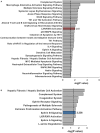Proteomic Correlates and Prognostic Significance of Kidney Injury in Heart Failure With Preserved Ejection Fraction
- PMID: 39206761
- PMCID: PMC11646498
- DOI: 10.1161/JAHA.123.033660
Proteomic Correlates and Prognostic Significance of Kidney Injury in Heart Failure With Preserved Ejection Fraction
Erratum in
-
Correction to: Proteomic Correlates and Prognostic Significance of Kidney Injury in Heart Failure With Preserved Ejection Fraction.J Am Heart Assoc. 2024 Oct 15;13(20):e034256. doi: 10.1161/JAHA.123.034256. Epub 2024 Oct 11. J Am Heart Assoc. 2024. PMID: 39392137 Free PMC article. No abstract available.
Abstract
Background: Kidney disease is common in heart failure with preserved ejection fraction (HFpEF). However, the biologic correlates and prognostic significance of kidney injury (KI), in HFpEF, beyond the estimated glomerular filtration rate (eGFR), are unclear.
Methods and results: Using baseline plasma samples from the TOPCAT (Treatment of Preserved Cardiac Function Heart Failure With an Aldosterone Antagonist) trial, we measured the following KI biomarkers: cystatin-C, fatty acid-binding protein-3, Beta-2 microglobulin, neutrophil gelatinase-associated lipocalin, and kidney-injury molecule-1. Factor analysis was used to extract the common variability underlying these biomarkers. We assessed the relationship between the KI-factor score and the risk of death or HF-related hospital admission in models adjusted for the Meta-Analysis Global Group in Chronic Heart Failure risk score and eGFR. We also assessed the relationship between the KI factor score and ~5000 plasma proteins, followed by pathway analysis. We validated our findings among HFpEF participants in the Penn Heart Failure Study. KI was associated with the risk of death or HF-related hospital admission independent of the Meta-Analysis Global Group in Chronic Heart Failure risk score and eGFR. Both the risk score and eGFR were no longer associated with death or HF-related hospital admission after adjusting for the KI factor score. KI was predominantly associated with proteins and biologic pathways related to complement activation, inflammation, fibrosis, and cholesterol homeostasis. KI was associated with 140 proteins, which reproduced across cohorts. Findings regarding biologic associations and the prognostic significance of KI were also reproduced in the validation cohort.
Conclusions: KI is associated with adverse outcomes in HFpEF independent of baseline eGFR. Patients with HFpEF and KI exhibit a plasma proteomic signature indicative of complement activation, inflammation, fibrosis, and impaired cholesterol homeostasis.
Keywords: HFpEF; cardiorenal interactions; chronic kidney disease; kidney injury; outcomes; proteomics.
Figures






References
-
- Smith DH, Thorp ML, Gurwitz JH, McManus DD, Goldberg RJ, Allen LA, Hsu G, Sung SH, Magid DJ, Go AS. Chronic kidney disease and outcomes in heart failure with preserved versus reduced ejection fraction: the Cardiovascular Research Network PRESERVE study. Circ Cardiovasc Qual Outcomes. 2013;6:333–342. doi: 10.1161/CIRCOUTCOMES.113.000221 - DOI - PMC - PubMed
-
- Pfeffer MA, Claggett B, Assmann SF, Boineau R, Anand IS, Clausell N, Desai AS, Diaz R, Fleg JL, Gordeev I, et al. Regional variation in patients and outcomes in the Treatment of Preserved Cardiac Function Heart Failure with an Aldosterone Antagonist (TOPCAT) trial. Circulation. 2015;131:34–42. doi: 10.1161/CIRCULATIONAHA.114.013255 - DOI - PubMed
MeSH terms
Substances
Grants and funding
LinkOut - more resources
Full Text Sources
Medical
Research Materials
Miscellaneous

